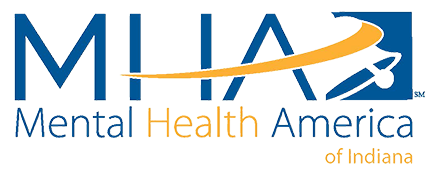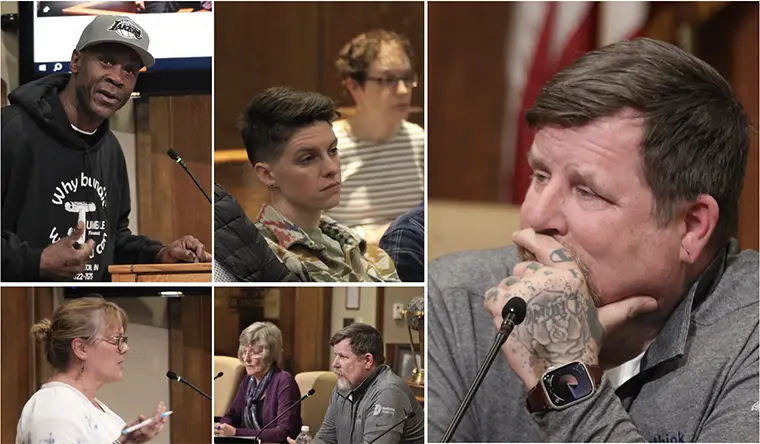By the end of March, local officials will likely know if Monroe County will be included in a program funded partly by the state, to help prisoners return to life outside the county jail.
That’s according to Jayme Whitaker, who is vice president of forensic services and director of the Integrated Reentry and Correctional Support (IRACS) program at Mental Health America of Indiana.
On Monday night, Whitaker fielded questions from an audience of government officials and community leaders who had gathered in the Nat U. Hill room at the Monroe County courthouse.
Monroe County is currently undergoing an assessment by Whitaker of its readiness to host an IRACS program. Part of that readiness assessment includes buy-in from all the relevant players, including the county sheriff.
Monroe County sheriff Ruben Marté attended Monday’s meeting, along with chief deputy sheriff Phil Parker and jail commander Kyle Gibbons.
Marté was quoted in a news release publicizing Monday’s saying, “This is a program that requires the collaboration and support of the court, the bar, local leaders and our recovery community. This is a jail program that reaches beyond the confines of my facility.”
It’s not just the sheriff who has to be on board. Whitaker ticked through the components that he is checking to confirm are in place, before recommending that Monroe County be added to the IRACS program.
Also a part of the social infrastructure that is needed to support IRACS are: leadership of the county and city; leaders in the criminal justice system; recovery community organizations; and a community that supports people who have lived-experience with the criminal justice system.
Also attending Monday’s meeting were Bloomington’s chief of police Mike Diekhoff, Bloomington mayor Kerry Thomson, and Bloomington city council president Isabel Piedmont-Smith. County commissioner Penny Githens co-hosted the meeting with Whitaker. Commissioners Lee Jones and Julie Thomas also attended.
Five Hoosier counties started an IRACS pilot in 2022: Blackford, Daviess, Dearborn, Delaware, and Scott.
According to Whitaker, in the pilot programs, 4,000 people had been helped, with a “success rate” of about 75 percent. Success is defined as whether someone sticks with the reentry program that has been developed in collaboration with the prisoner.
For example, the IRACS program tracks whether they followed the court’s orders, and stayed engaged with treatment services. If someone follows all the elements of their reentry program as tracked by IRACS then, that counts as a “successful,” Whitaker said.
The recidivism rate for people participating in IRACS was about 19 percent, Whitaker said. In the pilot program jails, there was an average decrease in jail population by about 23 percent, he said.
Based on the 2022 annual report from the Monroe County circuit court, the 19-percent recidivism rate for IRACS participants is comparable to the 18-percent recidivism seen in the drug court, one of Monroe County’s problem solving courts.
The problem solving courts—which include drug court, mental health court, reentry court, and veterans court—are overseen by circuit court judge Mary Ellen Diekhoff.
Diekhoff got a mention at the public mic during a turn from AJ (Antonio Jackson) who is owner of Big Boy’s Moving and Jumble Firewood
AJ called Diekhoff’s reentry court “a program that helped mold me into what I’m doing today.” He added, “I say that because the discipline and the accountability in her program kept me on a narrow road.”
AJ told the group, “I’m 52 years old, and I’ve served about 30 years of my life…from addiction to crack cocaine, starting at the age of 13 years old.” AJ said he didn’t come from a broken home or from the streets. He just made choices and the choices were reflected in his life, AJ said.
AJ led off his remarks by saying, “I know the inside of Monroe County jail, as if I was staff. I’ll say that because from 2005 to 2008, I sat in that jail for three years waiting to go to court.”
One of the basic pieces of infrastructure that IRACS relies on is local providers who are willing to partner with people with a criminal past. For AJ as a business owner, it’s not a case of being “willing to partner.” AJ said, “You cannot work for me if you have not committed a crime.”
AJ said, “It’s expensive to hire ex-felons. You gotta let him leave for two hours to go to a parole meeting. … He got to leave to go see his case management. But you know what we do? We drive him to that meeting, so he don’t lose four hours of pay—he can’t afford it. We drive, we wait, we bring him back to work.”
It is for-profit businesses, like his own, that provide the necessary jobs for people coming out of jail so that they can pay for housing so that they are not homeless, AJ said. Yet it is nonprofits that receive all the accolades and funding from local government, AJ said.
He put it like this: “It’s my company that they are calling to employ the guy who was released for murder. It’s me they’re calling to employ the registered sex offender. It’s me they’re calling to employ the person that relapsed. I’m the one left with the responsibility of making sure that this man or woman can earn an income, because it’s the income that creates the housing.”
“We ain’t got a penny from the city, in nine years I’ve been doing it,” AJ said.
As far as funding for nonprofits, AJ said, “I believe we have enough nonprofits in our community at this time.” He added that it is those nonprofits who actually have “boots to the ground” that deserve support. As examples of nonprofits like that, he gave Shalom Community Center (now Beacon, Inc.) and New Leaf New Life.
New Leaf New Life could wind up playing a pivotal role in the IRACS program, if Monroe County is selected for participation.
Every county that is selected for IRACS has to identify a recovery community organization (RCO) that will provide a center of operations for the program. In Monroe County, it is New Leaf New Life that has been identified as potentially playing that role.
New Leaf New Life executive director Jordan McIntire attended Monday’s meeting. Whitaker said he would be holding additional meetings, more narrowly focused on finalizing the specifics of the RCO.
From the public mic, Monroe County councilor Kate Wiltz asked Whitaker about the costs for the program. Whitaker said that depending on the size of the jail the cost could range between $350,000 to $500,000 per year.
Responding to a question from the B Square after Monday’s meeting, county commissioner Penny Githens said that the state would cover the cost of the certified peer recovery coaches (CPRCs) who would be working inside the jail. But the local community would need to cover the cost of the estimated three CPRCs who would be working outside the jail, according to Githens.
The county’s effort to become a participant in IRACS comes in the context of planning for construction of a new jail, to replace the facility at 7th Street and College Avenue. A consultant’s report from two and a half years ago concluded that the current jail is is failing to provide constitutional levels of care.





